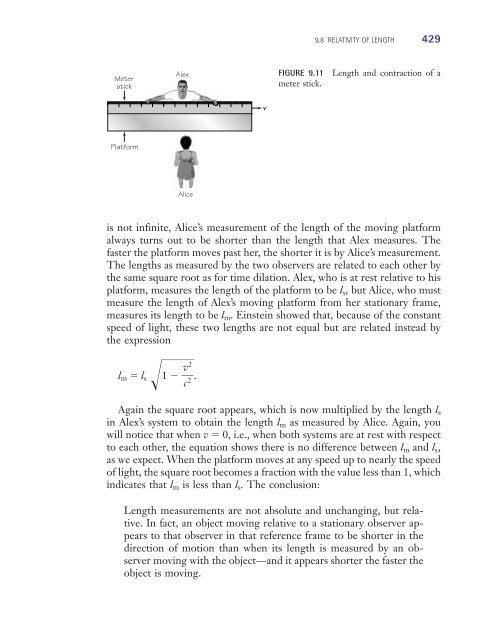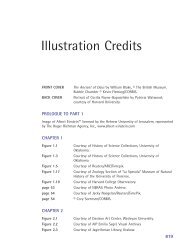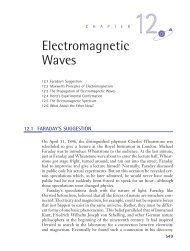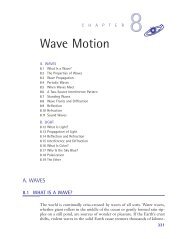Chapter 9: Einstein and Relativity Theory (319 KB) - D Cassidy Books
Chapter 9: Einstein and Relativity Theory (319 KB) - D Cassidy Books
Chapter 9: Einstein and Relativity Theory (319 KB) - D Cassidy Books
Create successful ePaper yourself
Turn your PDF publications into a flip-book with our unique Google optimized e-Paper software.
3637_<strong>Cassidy</strong>TX_09 6/14/02 12:08 PM Page 429<br />
9.8 RELATIVITY OF LENGTH 429<br />
Meter<br />
stick<br />
Alex<br />
FIGURE 9.11<br />
meter stick.<br />
Length <strong>and</strong> contraction of a<br />
v<br />
Platform<br />
Alice<br />
is not infinite, Alice’s measurement of the length of the moving platform<br />
always turns out to be shorter than the length that Alex measures. The<br />
faster the platform moves past her, the shorter it is by Alice’s measurement.<br />
The lengths as measured by the two observers are related to each other by<br />
the same square root as for time dilation. Alex, who is at rest relative to his<br />
platform, measures the length of the platform to be l s , but Alice, who must<br />
measure the length of Alex’s moving platform from her stationary frame,<br />
measures its length to be l m . <strong>Einstein</strong> showed that, because of the constant<br />
speed of light, these two lengths are not equal but are related instead by<br />
the expression<br />
v 2<br />
l m l s<br />
1 .<br />
c<br />
2<br />
Again the square root appears, which is now multiplied by the length l s<br />
in Alex’s system to obtain the length l m as measured by Alice. Again, you<br />
will notice that when v 0, i.e., when both systems are at rest with respect<br />
to each other, the equation shows there is no difference between l m <strong>and</strong> l s ,<br />
as we expect. When the platform moves at any speed up to nearly the speed<br />
of light, the square root becomes a fraction with the value less than 1, which<br />
indicates that l m is less than l s . The conclusion:<br />
Length measurements are not absolute <strong>and</strong> unchanging, but relative.<br />
In fact, an object moving relative to a stationary observer appears<br />
to that observer in that reference frame to be shorter in the<br />
direction of motion than when its length is measured by an observer<br />
moving with the object—<strong>and</strong> it appears shorter the faster the<br />
object is moving.






